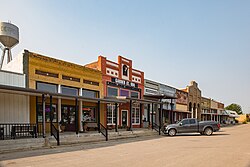Detroit, Texas
Detroit, Texas | |
|---|---|
 U.S. Route 82 and East Garner Drive in Detroit | |
 Location of Detroit, Texas | |
 | |
| Coordinates: 33°39′37″N 95°15′59″W / 33.66028°N 95.26639°W | |
| Country | United States |
| State | Texas |
| County | Red River |
| Area | |
• Total | 1.58 sq mi (4.10 km2) |
| • Land | 1.58 sq mi (4.10 km2) |
| • Water | 0.00 sq mi (0.00 km2) |
| Elevation | 482 ft (147 m) |
| Population (2020) | |
• Total | 704 |
| • Density | 431.46/sq mi (166.55/km2) |
| Time zone | UTC-6 (Central (CST)) |
| • Summer (DST) | UTC-5 (CDT) |
| ZIP code | 75436 |
| Area code(s) | 903, 430 |
| FIPS code | 48-20128[3] |
| GNIS feature ID | 2412421[2] |
| Website | [1] |
Detroit (dɪˈtɹɔɪt) is a town in Red River County, Texas, United States. The population was 704 at the 2020 census.
Notable person
[edit]John Nance Garner, 32nd Vice President of the United States, was born outside of Detroit but lived most of his life in Uvalde, on the southern rim of the Texas Hill Country.
Geography
[edit]According to the United States Census Bureau, the town has a total area of 1.6 square miles (4.1 km2), all land.
Demographics
[edit]| Census | Pop. | Note | %± |
|---|---|---|---|
| 1940 | 1,064 | — | |
| 1950 | 679 | −36.2% | |
| 1960 | 576 | −15.2% | |
| 1970 | 668 | 16.0% | |
| 1980 | 805 | 20.5% | |
| 1990 | 706 | −12.3% | |
| 2000 | 776 | 9.9% | |
| 2010 | 732 | −5.7% | |
| 2020 | 704 | −3.8% | |
| U.S. Decennial Census[4] | |||
| Race | Number | Percentage |
|---|---|---|
| White (NH) | 578 | 82.1% |
| Black or African American (NH) | 68 | 9.66% |
| Native American or Alaska Native (NH) | 4 | 0.57% |
| Asian (NH) | 1 | 0.14% |
| Some Other Race (NH) | 3 | 0.43% |
| Mixed/Multi-Racial (NH) | 27 | 3.84% |
| Hispanic or Latino | 23 | 3.27% |
| Total | 704 |
As of the 2020 United States census, there were 704 people, 283 households, and 192 families residing in the town.
As of the census[3] of 2000, there were 776 people, 315 households, and 217 families residing in the town. The population density was 490.7 inhabitants per square mile (189.5/km2). There were 359 housing units at an average density of 227.0 per square mile (87.6/km2). The racial makeup of the town was 78.35% White, 16.49% African American, 0.64% Native American, 1.68% from other races, and 2.84% from two or more races. Hispanic or Latino of any race were 2.58% of the population.
There were 315 households, out of which 33.0% had children under the age of 18 living with them, 48.6% were married couples living together, 16.2% had a female householder with no husband present, and 31.1% were non-families. 29.5% of all households were made up of individuals, and 15.6% had someone living alone who was 65 years of age or older. The average household size was 2.46 and the average family size was 3.06.
In the town, the population was spread out, with 29.4% under the age of 18, 8.5% from 18 to 24, 25.6% from 25 to 44, 20.7% from 45 to 64, and 15.7% who were 65 years of age or older. The median age was 34 years. For every 100 females, there were 83.5 males. For every 100 females age 18 and over, there were 80.3 males.
The median income for a household in the town was $25,250, and the median income for a family was $31,136. Males had a median income of $23,750 versus $17,250 for females. The per capita income for the town was $14,331. About 20.8% of families and 24.0% of the population were below the poverty line, including 34.4% of those under age 18 and 14.8% of those age 65 or over.
Education
[edit]Detroit is served by the Detroit Independent School District.
Gallery
[edit]-
First Christian Church
-
Old building
-
John Nance Garner House
References
[edit]- ^ "2019 U.S. Gazetteer Files". United States Census Bureau. Retrieved August 7, 2020.
- ^ a b U.S. Geological Survey Geographic Names Information System: Detroit, Texas
- ^ a b "U.S. Census website". United States Census Bureau. Retrieved January 31, 2008.
- ^ "Census of Population and Housing". Census.gov. Retrieved June 4, 2015.
- ^ "Explore Census Data". data.census.gov. Retrieved May 24, 2022.
- ^ "About the Hispanic Population and its Origin". www.census.gov. Retrieved May 18, 2022.




